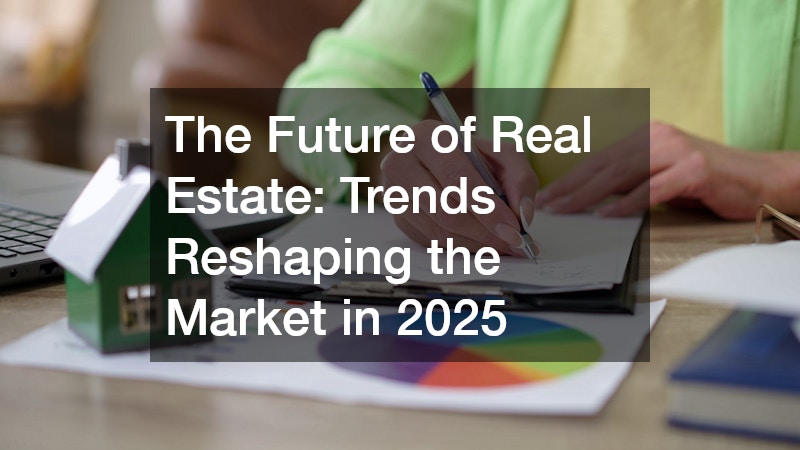The real estate landscape in 2025 is undergoing rapid transformation, driven by technology, demographic shifts, sustainability demands and changing consumer expectations. As the industry adapts to these developments, new opportunities and challenges are emerging for buyers, sellers, investors and professionals alike.
Understanding the major trends reshaping the market is essential to staying competitive and making informed decisions.
Proptech Disruption: Digital Takes Over
One of the most profound influences on landholdings in 2025 is the continued rise of proptech—property technology that streamlines and enhances every aspect of the property lifecycle. From AI-powered valuation tools to blockchain-based transactions, technology is redefining how property is bought, sold, leased and managed.
Virtual and augmented reality are now standard tools in the property marketing arsenal, enabling potential buyers and renters to tour homes remotely in immersive detail. AI chatbots and automated platforms handle much of the initial buyer engagement, offering instant responses and tailored listings. This shift has significantly reduced the need for face-to-face meetings in the early stages of transactions.
Blockchain is also playing a growing role in improving transparency and reducing fraud. Smart contracts are being used to automate escrow processes, enabling faster, more secure settlements. For property developers and large investors, digital twins—virtual replicas of physical buildings—offer valuable data for performance monitoring and predictive maintenance.
Changing Demographics & Urbanisation
Demographic trends are reshaping where and how people live. In Australia and globally, Millennials and Gen Z are entering the property market with different expectations than previous generations. They are prioritising affordability, connectivity and sustainability, often opting for compact, well-located apartments over traditional detached homes in the suburbs.
The growth of regional and secondary cities is another key trend. Accelerated by remote work, many Australians are choosing lifestyle-rich regional areas over expensive capital cities. This shift is boosting demand in places like Ballarat, Newcastle and the Sunshine Coast, prompting local councils and developers to rethink infrastructure, zoning and housing supply.
Meanwhile, Australia’s ageing population is fuelling demand for retirement living and accessible housing. Developers are incorporating universal design principles into new builds, while aged care providers are innovating with community-centric models that blend healthcare, social engagement and independent living.
The Sustainability Imperative
Sustainability is no longer optional in real property. Buyers and tenants increasingly expect energy-efficient, environmentally friendly properties and regulators are mandating higher standards. In 2025, compliance with the National Construction Code’s new energy efficiency provisions is a baseline expectation.
Sustainable buildings attract premium prices and higher occupancy rates. Features such as solar panels, battery storage, smart energy management systems and sustainable materials are now critical selling points. Green Star and NABERS ratings are being scrutinised by environmentally conscious investors and corporate tenants alike.
For developers, retrofitting older buildings to meet new environmental standards is both a challenge and an opportunity. Adaptive reuse of commercial spaces—for example, converting underutilised office buildings into residential apartments—is gaining popularity, reducing urban sprawl and lowering carbon footprints.
Shifting Investment Strategies
Property investment strategies are evolving in response to market volatility and global uncertainty. Diversification across asset classes—such as industrial, logistics, build-to-rent (BTR) and mixed-use developments—is gaining momentum. The industrial and logistics sectors, buoyed by the e-commerce boom, remain particularly strong in 2025.
Build-to-rent has emerged as a major force in the Australian housing market. Institutional investors are increasingly backing BTR projects, drawn by stable long-term returns and growing renter demand. These developments are professionally managed, often include high-end amenities and are designed to foster community.
Fractional ownership and real estate tokenisation are also disrupting traditional investment models. These innovations allow individuals to invest in property through small digital shares, making the market more accessible and liquid. While regulatory frameworks are still catching up, the trend is gaining traction with younger, tech-savvy investors.
Consumer Expectations & Personalisation

Today’s consumers expect more than just bricks and mortar—they want personalised, convenient and connected living experiences. Smart home technologies, integrated with mobile apps and voice assistants, are becoming standard in new builds. Residents can now control lighting, temperature, security and appliances remotely.
Developers and property managers are focusing on customer experience, offering concierge services, co-working spaces, parcel lockers and on-demand maintenance. In mixed-use developments, the lines between home, work and play are blurring, with cafes, gyms, parks and retail integrated into the community fabric.
The future of real estate in 2025 is being shaped by innovation, sustainability, demographic change and evolving expectations. As the industry adapts to these powerful trends, agility, foresight and a commitment to quality will be essential for success. For stakeholders across the sector, embracing change is not just an option—it’s a necessity.
